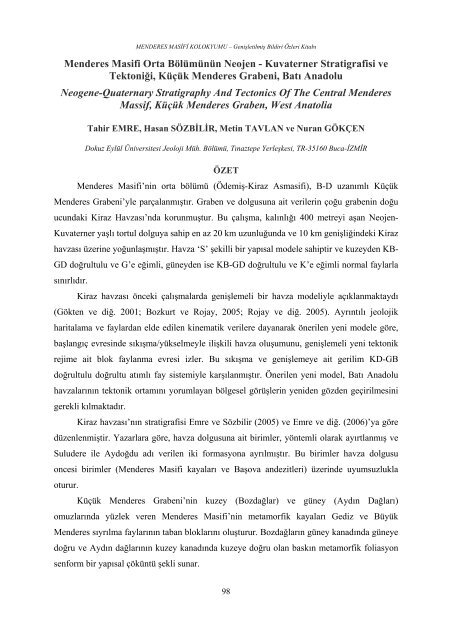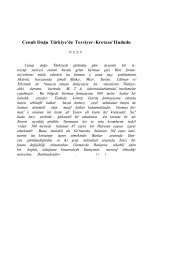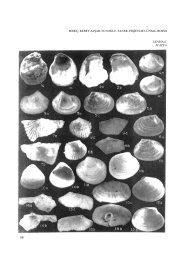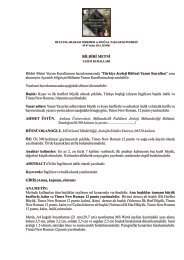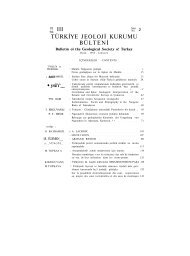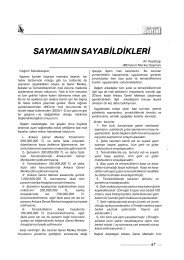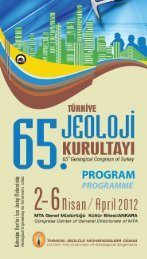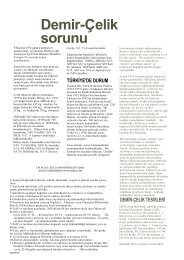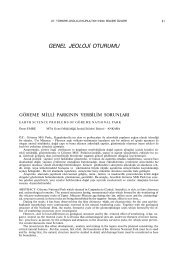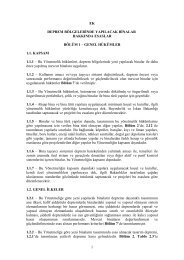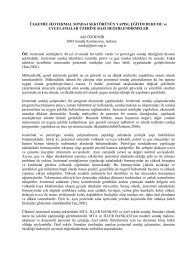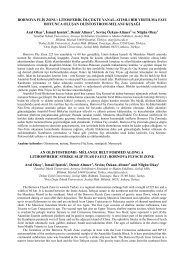Menderes Masifi'ndeki Jeolojik AraÅtırmaların Tarihsel GeliÅimi
Menderes Masifi'ndeki Jeolojik AraÅtırmaların Tarihsel GeliÅimi
Menderes Masifi'ndeki Jeolojik AraÅtırmaların Tarihsel GeliÅimi
You also want an ePaper? Increase the reach of your titles
YUMPU automatically turns print PDFs into web optimized ePapers that Google loves.
MENDERES MASİFİ KOLOKYUMU – Genişletilmiş Bildiri Özleri Kitabı<br />
<strong>Menderes</strong> Masifi Orta Bölümünün Neojen - Kuvaterner Stratigrafisi ve<br />
Tektoniği, Küçük <strong>Menderes</strong> Grabeni, Batı Anadolu<br />
Neogene-Quaternary Stratigraphy And Tectonics Of The Central <strong>Menderes</strong><br />
Massif, Küçük <strong>Menderes</strong> Graben, West Anatolia<br />
Tahir EMRE, Hasan SÖZBİLİR, Metin TAVLAN ve Nuran GÖKÇEN<br />
Dokuz Eylül Üniversitesi Jeoloji Müh. Bölümü, Tınaztepe Yerleşkesi, TR-35160 Buca-İZMİR<br />
ÖZET<br />
<strong>Menderes</strong> Masifi’nin orta bölümü (Ödemiş-Kiraz Asmasifi), B-D uzanımlı Küçük<br />
<strong>Menderes</strong> Grabeni’yle parçalanmıştır. Graben ve dolgusuna ait verilerin çoğu grabenin doğu<br />
ucundaki Kiraz Havzası’nda korunmuştur. Bu çalışma, kalınlığı 400 metreyi aşan Neojen-<br />
Kuvaterner yaşlı tortul dolguya sahip en az 20 km uzunluğunda ve 10 km genişliğindeki Kiraz<br />
havzası üzerine yoğunlaşmıştır. Havza ‘S’ şekilli bir yapısal modele sahiptir ve kuzeyden KB-<br />
GD doğrultulu ve G’e eğimli, güneyden ise KB-GD doğrultulu ve K’e eğimli normal faylarla<br />
sınırlıdır.<br />
Kiraz havzası önceki çalışmalarda genişlemeli bir havza modeliyle açıklanmaktaydı<br />
(Gökten ve diğ. 2001; Bozkurt ve Rojay, 2005; Rojay ve diğ. 2005). Ayrıntılı jeolojik<br />
haritalama ve faylardan elde edilen kinematik verilere dayanarak önerilen yeni modele göre,<br />
başlangıç evresinde sıkışma/yükselmeyle ilişkili havza oluşumunu, genişlemeli yeni tektonik<br />
rejime ait blok faylanma evresi izler. Bu sıkışma ve genişlemeye ait gerilim KD-GB<br />
doğrultulu doğrultu atımlı fay sistemiyle karşılanmıştır. Önerilen yeni model, Batı Anadolu<br />
havzalarının tektonik ortamını yorumlayan bölgesel görüşlerin yeniden gözden geçirilmesini<br />
gerekli kılmaktadır.<br />
Kiraz havzası’nın stratigrafisi Emre ve Sözbilir (2005) ve Emre ve diğ. (2006)’ya göre<br />
düzenlenmiştir. Yazarlara göre, havza dolgusuna ait birimler, yöntemli olarak ayırtlanmış ve<br />
Suludere ile Aydoğdu adı verilen iki formasyona ayrılmıştır. Bu birimler havza dolgusu<br />
oncesi birimler (<strong>Menderes</strong> Masifi kayaları ve Başova andezitleri) üzerinde uyumsuzlukla<br />
oturur.<br />
Küçük <strong>Menderes</strong> Grabeni’nin kuzey (Bozdağlar) ve güney (Aydın Dağları)<br />
omuzlarında yüzlek veren <strong>Menderes</strong> Masifi’nin metamorfik kayaları Gediz ve Büyük<br />
<strong>Menderes</strong> sıyrılma faylarının taban bloklarını oluşturur. Bozdağların güney kanadında güneye<br />
doğru ve Aydın dağlarının kuzey kanadında kuzeye doğru olan baskın metamorfik foliasyon<br />
senform bir yapısal çöküntü şekli sunar.<br />
98
MENDERES MASİFİ KOLOKYUMU – Genişletilmiş Bildiri Özleri Kitabı<br />
<strong>Menderes</strong> Masifi kayalarını kesen volkanik kayalar; Kiraz ilçesi KD’sinde Başova,<br />
D’sinde Karaburç ve GD’sinde Yenişehir köyleri çevresinde yüzlek verir. Oldukça küçük<br />
alanlar kaplayan bu yüzlekler, KD-GB uzanımlı bir hat boyunca dizilir. Başova ve<br />
Karaburç’un pembe ve gri renkli andezitik kayaları, hipokristalen porfirik doku, yer yer<br />
hyalopilitik dokudadır. Yenişehir’deki, koyu gri, yeşilimsi gri renkli, ince taneli bazaltik<br />
andezitlerde, makroskobik olarak plajioklas ve piroksen fenokristalleri seçilebilir. Kayaçların<br />
tümü LIL elementleri bakımından oldukça, HFSE elementleri bakımındansa daha az<br />
zenginleşmiştir. Başova’dan alınan örnekler, 40 Ar/ 39 Ar yöntemiyle yapılan radyometrik yaş<br />
tayinine göre, 14,7±0,1 My, bunların 12 km GB’sindeki Yenişehir’den alınan örnekler ise<br />
14,3±0,1 My yaşını verir (Emre ve Sözbilir 2005). Volkanitlerin iz element ve ender toprak<br />
element dağılım diyagramları, genel olarak, kalk-alkali yay volkanitlerinin ya da orojenik<br />
volkanitlerin desenine benzer.<br />
Kiraz havzası farklı özellikteki iki ana tortul paketle doldurulmuştur. Yaşlı paket (en üst<br />
Orta Miyosen-Geç Miyosen yaşlı Suludere formasyonu) ters fay ve doğrultu atımlı faylarla<br />
kontrol edilen havza kuzey kenarındaki yükselme ve K-G duğrultulu sıkışma kuvvetleriyle<br />
ilişkili olarak gelişmiştir. Bu durum alg ve ostrakodların yaşamasına uygun koşulların<br />
sağlandığı sığ göllerle örtülü senklinal şekilli çöküntülarin gelişmesini sonuçlamıştır. Bu tatlı<br />
su gölleri başlangıçta açık denizle bağlantılı yüzey akıntılarının etkisindeyken, daha sonra<br />
denizel katkı tamamen yerini menderesli nehir çöklleri ve taşkın düzlüğü tortullarına<br />
bırakmıştır.<br />
Bu evre sırasında <strong>Menderes</strong> Masifi’ne ait metamorfik kayalar ve Orta Miyosen yaşlı<br />
andezitik volkanitler (Başova andezitleri) temeli oluşturmaktaydı ve bu temel üzerinde açınan<br />
tortul havza ekseni kuzey kenar boyunca yer almaktaydı. Sıkışma/yükselme sonucu,<br />
tabandaki uyumsuzluk yüzeyi havza merkezine doğru eğimlenir ve giderek düşey, hatta<br />
devrik konum kazanır. Çoğu yerde düşük eğim açılı olan Miyosen tortulları havzanın kuzey<br />
kenarı boyunca yoğun bir deformasyona uğramıştır. Bu tortullardaki formasyon içi<br />
uyumsuzluklar tektonikle eş yaşlı tortullaşmanın yansıması olarak kendini gösterir. Geç<br />
Miyosen’i izleyen evrede, <strong>Menderes</strong> Masifi’nin Miyosen tortulları üzerine bindirmesi,<br />
Suludere formasyonu’na ait tortullaşmanın sona ermesinden sonra da sıkışma tektoniğinin<br />
varlığını kanıtlar. Suludere formasyonu ile Aydoğdu formasyonu arasındaki uyumsuzluk Geç<br />
Miyosen sonrasındaki çökelim boşluğuna işaret eder ve Gediz Grabeni (Koçyiğit ve diğ.,<br />
1999) ile Küçük <strong>Menderes</strong> Grabeni’nde (Bozkurt ve Rojay 2005) tanımlanan Alt-Orta<br />
Pliyosen sıkışma fazına karşılık gelebilir. Kiraz havzasını kuzeyden ve güneyden sınırlayan<br />
99
MENDERES MASİFİ KOLOKYUMU – Genişletilmiş Bildiri Özleri Kitabı<br />
Suludere ve Halıköy faylarının kontrölünde gelişen Pliyo-Pleyistosen yaşlı Aydoğdu<br />
formasyonu, genişlemeli tektonik rejiminin başladığını belgeler. Bu evrenin yapısal<br />
elemanları önceki evreye ait sıkışmayla ilişkili yapılar üzerinde işlemiş ve bu yapıları<br />
maskelemiştir. Bu evre havzanın K-G doğrultusunda günümüze kadar genişlemesine katkıda<br />
bulunmaktadır.<br />
Kiraz havzasındaki faylardan toplanan kinematik veriler ışığında, dört deformasyon<br />
fazı tanımlanmıştır: (i) kuzeye ve güneye doğru tektonik taşınma veren D1 ve D2<br />
deformasyon fazları Kiraz Havzası’nın oluşumu öncesinde gelişmiştir. (ii) D3 deformasyon<br />
fazı havzasnın ilk evresindeki tortullaşmayla eşyaşlı ve tortullaşma sonrası tektonikle<br />
ilişkilidir ve formasyon-içi uyumsuzluklar ile ters faylarla kendini gösterir. (iii) D4<br />
deformasyonu yaşlı yapıları kesen ve günümüzdeki Kiraz havzasını şekillendiren normal<br />
fayların gelişmesini sağlamıştır (Emre ve Sözbilir, 2007).<br />
Sonuç olarak, bu çalışmada Kiraz havzasının iki aşamada evrimleştiği önerilmektedir;<br />
yaşlı çökeller ters fay ve doğrultu atımlı faylarla kontrol edilmiştir, daha sonra havzanın karşıt<br />
kenarlarında oluşan normal fay sistemi ikinci evreyi simgelemektedir.<br />
Anahtar kelimeler: Küçük <strong>Menderes</strong> Grabeni, Kiraz havzası, sıkışmayla eşyaşlı tortullaşma,<br />
gerilmeli tektonik, Batı Anadolu<br />
ABSTARCT<br />
The Central <strong>Menderes</strong> Massif (also known as Ödemiş-Kiraz Sub-massif) is dissected by E-W<br />
trending Kuçuk <strong>Menderes</strong> Graben that most of the basin-fill units deposited at its eastern end, namely<br />
the Kiraz basin. This study focused on the Kiraz basin that is a minimum 20 km long and more than 10<br />
km wide, and its Neogene to Quaternary sediment pile exceeds 400 m in thickness. The basin showing<br />
‘S’ shaped structural pattern is bounded from the north by NW-SE trending and S-facing high-angle<br />
normal faults, and from the south by NW-SE trending and N-facing normal faults<br />
The Kiraz basin was previously considered to be an extensional basin (Gökten et. al.. 2001;<br />
Bozkurt and Rojay, 2005; Rojay et.al. 2005). However, the data presented here allow us to infer that<br />
the tectonic evolution of the Kiraz basin could be explained by an alternative model indicating<br />
compression/uplift related basin formation at the early stage of the basin evolution followed by block<br />
faulting of extensional neotectonic regime. The successive compressional and extensional strain is<br />
accommodated by a predominantly NE-trending strike-slip fault system. The new model is based on<br />
the detailed mapping, field-coss sections and kinematic analyses of the studied faults. This induces to<br />
outline a revision of the regional existent approaches related to tectonic setting of the west Anatolian<br />
basins.<br />
100
MENDERES MASİFİ KOLOKYUMU – Genişletilmiş Bildiri Özleri Kitabı<br />
The stratigraphy of the Kiraz basin is based on the recently published paper of Emre et al.<br />
(2006). According to authors, the basin fill units, formally distinguished and has been divided into two<br />
formations: the Suludere and Aydoğdu formations (Figure 3). These units rest unconformably on the<br />
pre-basin fill units (e.g. Metamorphic rocks of the <strong>Menderes</strong> Massif and Başova Andesites).<br />
The metamorphic rocks of the <strong>Menderes</strong> Massif predominantly exposed on the northern<br />
(Bozdağ Mountain) and southern (Aydın Mountain) shoulders of the Küçük <strong>Menderes</strong> Graben are<br />
formed the footwall rocks of the Gediz detachment fault and Büyük <strong>Menderes</strong> detachment fault,<br />
respectively. Predominant foliation of the metamorphic rocks down to the south on the southern flank<br />
of the Bozdağ Mountain and down to the north in the northern flank of the Aydın Mountain shows<br />
synform-like structural depression.<br />
The <strong>Menderes</strong> metamorphics are cut by young volcanics which crop out to the NE, E and SE of<br />
Kiraz around Başova, Karaburç and Yenişehir villages in turn. The volcanic rock outcrops from a NE-<br />
SW trend and small in areal extent. The pink and grey colored volcanic rocks around Başova and<br />
Karaburç villages are andesitic in composition with hypocrystalline-porphyritic to hyaloplitic in<br />
texture. Around Yenişehir, the volcanic rocks are dark gray and greenish grey in color and include<br />
plagioclase and pyroxene phenocrysts. The volcanic rocks are highly enriched in LIL elements and<br />
partially enriched in HFSE elements. On the basis of 40 Ar/ 39 Ar radiometric age determinations,<br />
samples taken from Aykıran Tepe yielded an age of 14.7±0.1 Ma, and those from Yenişehir, an age of<br />
14.3±0.1 Ma (Emre and Sözbilir 2005). Trace element and rare earth element diagrams of the studied<br />
volcanics resemble to the nature of calcalkaline arc volcanics or orogenic volcanics.<br />
The Kiraz basin is filled by two contrasting sedimentary packages. The older one (the<br />
Uppermost Middle Miocene-Late Miocene Suludere formation) is developed in relation to N-S<br />
trending compressional tectonics and uplift along the northern margin of the basin that controlled by<br />
reverse and strike-slip faults. This was resulted in a syncline-shaped depression that was covered by<br />
small lakes of only moderate depth, but with conditions suitable for algae and ostracodes to survive.<br />
These fresh-water coastal lakes were originally under the influence of surface streams that were<br />
connected to the open sea, but in later periods there was no marine contribution. Shallow-lake<br />
carbonates were followed upward by slightly meandering-river-channel and floodplain sediments.<br />
During this stage, the main sedimentary trough was located along the northern margin where<br />
metamorphic rocks of the <strong>Menderes</strong> Massif and Middle Miocene andesitic volcanism (Başova<br />
andesites) form the basement. The basal unconformity with the basement rocks have been tilted to<br />
vertical, even if overturned record the uplift linked to the activity along the reverse/thrust fault. The<br />
Miocene strata are nearly horizontal over most of their extent and highly deformed only along the<br />
northern margin of the basin where syntectonic activity is recorded by the development of<br />
untraformational unconformities. Following the Late Miocene, thrusting of <strong>Menderes</strong> Massif rocks<br />
onto the Miocene sediments indicate that the compressional regime was active after the sedimentation<br />
101
MENDERES MASİFİ KOLOKYUMU – Genişletilmiş Bildiri Özleri Kitabı<br />
of the Suludere formation. The angular unconformity between the Suludere and Aydoğdu formations<br />
marks this post-Late Miocene depositional hiatus that may correspond to a Lower-Middle Pliocene<br />
compressional phase described from Gediz Graben (Koçyiğit et al., 1999) and Küçük <strong>Menderes</strong><br />
Graben (Bozkurt and Rojay 2005). The development of the Plio-Pleistocene Aydoğdu formation, under<br />
the control of the Suludere and Halıköy faults that bound the Kiraz basin on the north and south,<br />
demonstrate that the extensional tectonic regime initiated the second stage sedimentation within the<br />
Kiraz basin. Structural elements of this stage have superposed and masked on the former<br />
contractional structures. This extensional phase corresponds to a widening of the basin in N-S<br />
direction up to present.<br />
On the basis of kinematic data collected from faults observed in the Kiraz basin, four<br />
deformation phases have been recognized: (i) D 1 and D 2 deformations indicate north- and southdirected<br />
tectonic transport that pre-date the formation of the Kiraz basin; (ii) D 3 deformation,<br />
reflecting syn- to post-sedimentary tectonics that is represented by intraformational unconformities<br />
and related reverse faulting; (iii) D 4 deformation gave rise to normal faults that cut and displace early<br />
structures and shapes the Kiraz basin’s present-day configuration (Emre and Sözbilir, 2007).<br />
In conclusion, it is proposed here that the Kiraz Basin evolved during two stage history; oldest<br />
deposits were controlled by the combined activity of reverse fault and strike-slip fault systems, and<br />
then by the normal fault system that formed on the opposite basin margin.<br />
Key words: Küçük <strong>Menderes</strong> Graben, Kiraz basin, syn-compressional sedimentation, extensional<br />
tectonics, West Anatolia<br />
DEĞİNİLEN BELGELER / REFERENCES<br />
Bozkurt, E. ve Rojay, B. 2005. Episodic, Two-Stage Neogene Extension And Short-Term İntervening<br />
Compression İn Western Anatolia: field evidence from the Kiraz basin and Bozdağ Horst. Geodinamica<br />
Acta 18/3–4, 295–312.<br />
Emre, T. ve Sözbilir, H. 2005. Küçük <strong>Menderes</strong> Grabeni Doğu Ucundaki Andezitlerin (Başova-Kiraz/İzmir)<br />
Jeolojisi, Petrografisi Ve Jeokimyası. Maden Tetkik ve Arama (MTA) Dergisi131, 1–19[Türkçe baskı].<br />
Geology, Geochemistry and Geochronology of the Başova Andesite, Eastern end of the Küçük <strong>Menderes</strong><br />
Graben. Mineral Research and Exploration (MTA) Bulletin 131, 1–19 [English edition].<br />
Emre, T. ve Sözbilir, H. 2007. Tectonic Evolution of the Kiraz Basin, Küçük <strong>Menderes</strong> Graben: Evidence for<br />
compression/uplift-related basin formation overprinted by extensional tectonics in West Anatolia Turkish<br />
Journal of Earth Sciences 16, In Pres.<br />
Emre, T. ve Sözbilir, H. ve Gökçen, N. 2006. Kiraz - Beydağ Çevresinin Neojen- Kuvaterner Stratigrafisi,<br />
Küçük <strong>Menderes</strong> Grabeni, Batı Anadolu. Maden Tetkik ve Arama (MTA) Dergisi 132, 1–32 [Türkçe<br />
baskı].Neogene-Quternary stratigraphy of Kiraz-Beydağ region, Küçük <strong>Menderes</strong> Graben, West<br />
Anatolia. Mineral Research and Exploration (MTA) Bulletin 132, 1–32 [English edition].<br />
Gökten, E., Havzaoğlu, Ş. ve Şan, Ö. 2001. Tertiary evolution of the central <strong>Menderes</strong> Massif based on structural<br />
investigations of metamorphics and sedimentary cover rocks between Salihli and Kiraz (western Turkey).<br />
International Journal of Earth Sciences 89, 745–756.<br />
Koçyiğit, A., Yusufoğlu, H ve Bozkurt, E. 1999. Evidence from the Gediz graben for episodic two-stage<br />
extension in western Turkey. Journal of Geological Society, London 156, 605–616.<br />
Rojay, B., Toprak, V., Demirci, C. ve Süzen, L. 2005. Plio-Quaternary evolution of the Küçük <strong>Menderes</strong><br />
Graben Southwestern Anatolia, Turkey. Geodinamica Acta 18, 317–331.<br />
102


